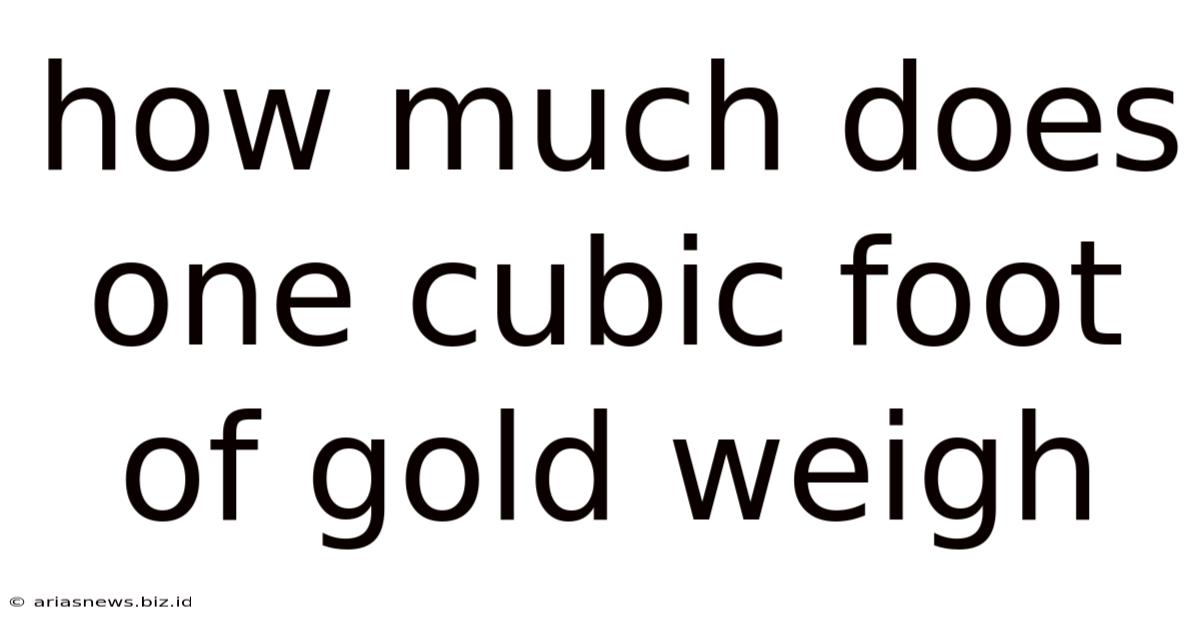How Much Does One Cubic Foot Of Gold Weigh
Arias News
May 12, 2025 · 4 min read

Table of Contents
How Much Does One Cubic Foot of Gold Weigh? A Deep Dive into Density and its Implications
Gold, a symbol of wealth, luxury, and prestige, has captivated humanity for millennia. Its inherent value, coupled with its unique physical properties, makes it a fascinating subject of study. One intriguing question that often arises is: how much does one cubic foot of gold weigh? The answer, while seemingly simple, involves a deeper understanding of density, volume, and the implications of these factors in various applications.
Understanding Density: The Key to Weighing Gold
The weight of one cubic foot of gold isn't a fixed, arbitrary number. It's directly tied to the density of gold. Density is a measure of mass per unit volume; in simpler terms, it's how much "stuff" is packed into a given space. Gold is renowned for its high density – it's exceptionally heavy for its size. This high density is a defining characteristic that contributes to its value and many of its applications.
The density of gold is typically given as 19.3 g/cm³ (grams per cubic centimeter). This means that one cubic centimeter of gold weighs 19.3 grams. However, to answer our original question about a cubic foot of gold, we need to perform some unit conversions.
From Cubic Centimeters to Cubic Feet: The Conversion Process
The conversion from cubic centimeters to cubic feet requires a bit of mathematical maneuvering. There are approximately 28316.8 cubic centimeters in one cubic foot. Therefore, to find the weight of one cubic foot of gold, we multiply the density of gold by this conversion factor:
19.3 g/cm³ * 28316.8 cm³/ft³ ≈ 546,000 g/ft³
This gives us the weight in grams. To express this in more common units, like pounds or kilograms, we need to further convert:
- Grams to Kilograms: Divide by 1000: 546,000 g / 1000 g/kg = 546 kg
- Grams to Pounds: Divide by 453.592: 546,000 g / 453.592 g/lb ≈ 1204 lbs
Therefore, one cubic foot of gold weighs approximately 546 kilograms or 1204 pounds.
Factors Affecting the Precise Weight
While the calculations above provide a close approximation, several factors can subtly influence the precise weight of a cubic foot of gold:
Purity of the Gold:
The purity of the gold significantly impacts its density and therefore its weight. Pure, 24-karat gold will have a density very close to the 19.3 g/cm³ figure. However, most gold items are alloys – mixtures of gold with other metals like silver, copper, or zinc. These alloying metals can slightly alter the overall density, resulting in a marginally different weight for a cubic foot. A lower karat gold will weigh slightly less.
Temperature and Pressure:
While the effect is minimal, temperature and pressure can influence the density of gold. Higher temperatures cause materials to expand slightly, decreasing density. Conversely, increased pressure would compress the gold, slightly increasing its density. These effects are usually negligible in everyday scenarios, but they become significant in high-pressure environments or at extreme temperatures.
Imperfections in the Gold:
In real-world scenarios, gold might contain microscopic imperfections, voids, or impurities. These imperfections will reduce the overall density and, consequently, the weight of a cubic foot of gold. The degree of impact depends on the extent and nature of these imperfections.
Applications and Implications of Gold's High Density
The remarkably high density of gold has far-reaching consequences across various applications:
Jewelry and Ornaments:
Gold's density contributes to the impressive weight and feel of gold jewelry. A small volume of gold can still be quite heavy, signifying its value and luxury.
Investment and Finance:
The inherent density of gold makes it a compact store of value. A significant amount of wealth can be stored in a relatively small volume, which has implications for transportation and security.
Electronics:
Gold's excellent conductivity and resistance to corrosion, coupled with its density, make it ideal for electronic applications such as connectors and contacts. Its weight also contributes to its stability and durability in these uses.
Medical Applications:
In medicine, gold compounds are used in certain treatments. The density of gold might play a role in the delivery and efficacy of such compounds.
Nuclear Applications:
Gold's high density makes it useful in radiation shielding. This is due to its ability to absorb radiation particles effectively.
Industrial Applications:
Gold's high density is beneficial in specialized industrial applications such as dental work or plating.
Conclusion: More Than Just a Weight
Understanding the weight of one cubic foot of gold is more than just a simple calculation; it's a gateway to understanding the fundamental properties of this precious metal. The density of gold, its implications in diverse applications, and the nuances of factors affecting its precise weight make it a compelling subject of study. This in-depth exploration highlights the significance of density in various industries and applications, and how a seemingly simple question about weight can lead to a comprehensive understanding of gold's unique properties. The approximately 1204 pounds per cubic foot is a powerful testament to the inherent value and remarkable characteristics of this precious metal. The high density of gold isn't just a number; it's a key to understanding its role in shaping our world.
Latest Posts
Latest Posts
-
3 Meters Is Equal To How Many Centimeters
May 12, 2025
-
How Many Grams Are In 3 Kilograms
May 12, 2025
-
What Takes Place On The Narrators 19th Birthday
May 12, 2025
-
Adjectives To Describe Edgar Allen Poes Life
May 12, 2025
-
1872 Trade Dollar 420 Grains 900 Fine Value
May 12, 2025
Related Post
Thank you for visiting our website which covers about How Much Does One Cubic Foot Of Gold Weigh . We hope the information provided has been useful to you. Feel free to contact us if you have any questions or need further assistance. See you next time and don't miss to bookmark.